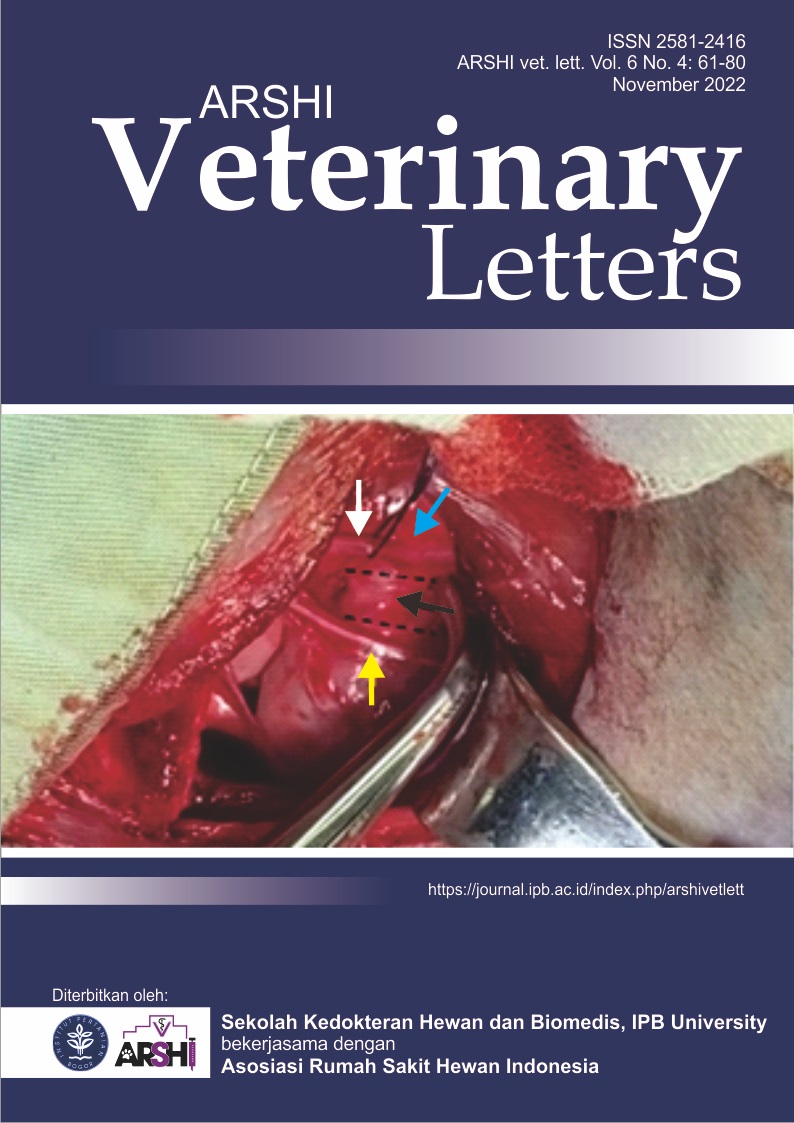Gambaran parameter fisiologi sebelum dan setelah penanganan pada kuda dengan kasus kolik ringan
Abstract
Kolik merupakan penyakit yang sering dialami oleh kuda. Kondisi kolik secara umum akan menyebabkan perubahan pada kondisi fisiologis kuda. Tulisan ini melaporkan kondisi parameter fisiologi sebelum dan setelah penanganan pada kuda yang mengalami kolik ringan. Beberapa gejala klinis yang muncul pada kedua kuda adalah menakur-nakur, memojok, napas terengah-engah, dan tidak memakan pelet. Hasil pemeriksaan parameter fisiologi kuda yang mengalami kolik ringan menunjukkan kedua kuda mengalami peningkatan frekuensi denyut jantung, frekuensi denyut nadi, frekuensi respirasi dan frekuensi peristaltik usus kuda hanya terdengar 1 kali. Temperatur tubuh dan warna mukosa kedua kuda dalam kondisi normal. Kedua kuda tidak berdefekasi sebelum penanganan. Kedua kuda diberikan terapi berupa penyuntikan obat non-steroidal anti-inflammatory drug (NSAID) flunixin intravena. Selain itu, kuda juga diajak berjalan-jalan dan dilakukan penundaan pemberian pakan. Hasil pemeriksaan parameter fisiologi kedua kuda setelah penanganan berhasil menurunkan frekuensi denyut jantung, frekuensi denyut nadi, frekuensi respirasi dari nilai sebelum penanganan menjadi normal. Peristaltik usus kedua kuda meningkat yang disertai dengan defekasi. Suhu tubuh dan warna mukosa kedua kuda dalam kondisi normal
Downloads
References
Bentz D, Bradford K. 2014. When a horse colic: The physical examination. The horse: your guide to equine health care. 10.
Bihonegn T, Bekele F. 2018. Colic in Equine: A review article. International Journal of Advanced Research in Biological Sciences. 5(5):185–195.
Camargo FC. 2011. Colic in Horses. Animal and Food Science. Lexington: University of Kentucky Collage of Agriculture.
Cook VL, Hassel DM. 2014. Evaluation of the colic in horses: decision for referral. Veterinary Clinics: Equine Practice. 30(2):383–398.
Gaina CD, Foeh NDFK. 2018. Studi performa umum tubuh dan status fisiologis kuda Sumba. Jurnal Kajian Veteriner. 6(2): 38–44.
Knych HK. 2017. Nonsteroidal anti-inflammatory drug use in horses. Veterinary Clinics: Equine Practice. 33(1):1– 15.
Mair T, Love S, Schumacher J, Smith RK, Frazer G. 2013. Equine Medicine Surgery and Reproduction. Elsevier Health Sciences.
Pellegrini-Masini A, Poppenga RH, Sweeney RW. 2004. Disposition of flunixin meglumine injectable preparation administered orally to healthy horses. Journal of Veterinary Pharmacology and Therapeutics. 27(3):183–186.
Williams S, Horner J, Orton E, Green M, McMullen S, Mobasheri A, Freeman SL. 2015. Water intake, faecal output and intestinal motility in horses moved from pasture to a stabled management regime with controlled exercise. Equine Veterinary Journal. 47(1):96-100.
Copyright (c) 2022 CC-BY-SA

This work is licensed under a Creative Commons Attribution-ShareAlike 4.0 International License.
Authors who publish with this journal agree to the following terms:
1. Authors retain copyright and grant the journal right of first publication with the work simultaneously licensed under a Creative Commons Attribution License that allows others to share the work with an acknowledgement of the work's authorship and initial publication in this journal.
2. Authors are able to enter into separate, additional contractual arrangements for the non-exclusive distribution of the journal's published version of the work (e.g., post it to an institutional repository or publish it in a book), with an acknowledgement of its initial publication in this journal.
3. Authors are permitted and encouraged to post their work online (e.g., in institutional repositories or on their website) prior to and during the submission process, as it can lead to productive exchanges, as well as earlier and greater citation of published work (See The Effect of Open Access).


.jpg)















